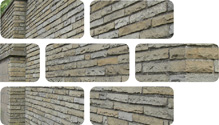
Wall Stone Inert 17 05 04
Wall stone is quarried material cut to size and shape, often with uneven edges. There are various types depending on location of the quarry including York, Portland, Bath Pennant, Cotswold and Purpeck. They are cut in various shapes and sizes, depending on the specification required. They are of varying quality, strength and finish depending on their expected function and architectural finish. Wall Stone can be very hard wearing and valuable.
Usage & Probable Locations
Wall stone is generally used for perimeter walls, planters, buildings, field boundaries, retaining walls, stone bridges and garden features. They are located in period buildings, old mills, civic buildings, cottages, large open spaces of towns and cities, churches, older hospitals, farmyards and a wide range of gardens.
Personal Protective Equipment
PPE requirements indicated are for guidance purposes only. DRIDS has identified the PPE that is mandatory on all demolition projects and ones that may be required subject to site specific Risk Assessment & Method Statement (RAMS). Hover over the icon to determine the types of PPE required for the removal of this material.
Removal, Segregation & Storage
Wall stone that is destined for reuse should be lifted, cleaned of mortar, segregated and stored carefully and safely, to ensure their integrity and good condition. They should be stacked on timber pallets and bound with cling-film to prevent tumbling and away from plant movements to prevent splash damage. Crushed wall stone that is destined for recycling should have the majority of contaminants removed to suit the quality protocol for recycled aggregates. There is no need to store palleted or crushed wall stone inside a building or under cover as they are robust against inclement weather.
Fixtures, Fittings & Connections
Wall stone has been traditionally laid in place as dry stone walling or through the use of lime mortar or other light-bonding mortar mix to bond the faces and edges of the stones together. The mortar is often pointed along the face of the wall. Some wall stone will be integrated with other materials to form a garden feature, architectural feature or ornamental feature. These will occasionally incorporate ties, pins or straps for stability.
Health & Safety
Subject to task-specific Risk Assessment & Method Statement (RAMS). Wear gloves when handling stone products and crushed materials to prevent irritation, cuts and abrasion. Use eye protection when using hand tools. Limit hand, arm and whole body vibration when using air tools. Only use 360 plant and attachments if appropriately trained.










